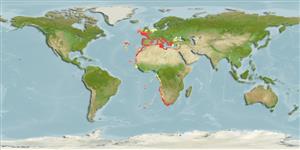Common names from other countries
Classification / Names / Names
Namen | Synonyme | Catalog of Fishes (gen., sp.) | ITIS | CoL | WoRMS
Environment: milieu / climate zone / depth range / distribution range
Ökologie
; tiefenbereich 3 - 871 m (Ref. 78235), usually 50 - 450 m (Ref. 8). Subtropical; 58°N - 41°S, 35°W - 38°E
Eastern Atlantic and the Mediterranean: from Ireland to Senegal, including the Azores and Canary Islands, and the entire Mediterranean. Temperate to tropical.
Length at first maturity / Size / Gewicht / Alter
Maturity: Lm ? range ? - ? cm Max length : 11.2 cm TL Männchen/unbestimmt; (Ref. 8)
Known from pelagic depths between 100 to 200 m (Ref. 92299). Occurs on muddy and sandy bottoms on the shelf and upper slope. Buries in the mud during the day and emerges at night (Ref. 80202). Feeds on benthic invertebrates living on soft bottom substrates like polychaetes, bivalves, gastropods and echinoderms (Ref. 106588).
Life cycle and mating behavior
Geschlechtsreife | Fortpflanzung | Ablaichen | Eier | Fecundity | Larven
Members of the order Decapoda are mostly gonochoric. Mating behavior: Precopulatory courtship ritual is common (through olfactory and tactile cues); usually indirect sperm transfer.
Holthuis, L.B. 1980. (Ref. 8)
IUCN Rote Liste Status (Ref. 130435)
CITES Status (Ref. 108899)
Not Evaluated
Not Evaluated
Nutzung durch Menschen
Fischereien: weniger kommerziell
| FishSource |
Tools
Internet Quellen
Estimates based on models
Preferred temperature
(Ref.
115969): 9.8 - 17, mean 13.7 (based on 593 cells).
Widerstandsfähigkeit
hoch, Verdopplung der Population dauert weniger als 15 Monate. (K=0.5-0.65).
Verwundbarkeit
Low vulnerability (10 of 100).
Preiskategorie
Unknown.
